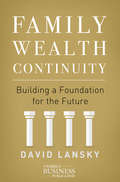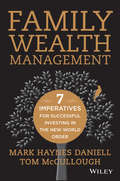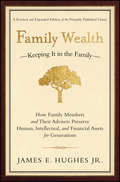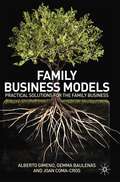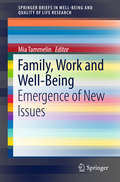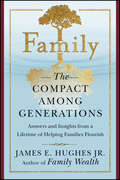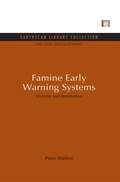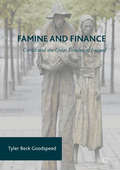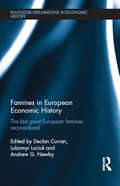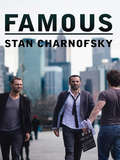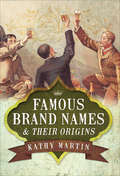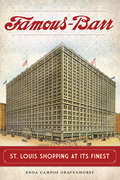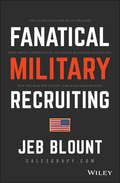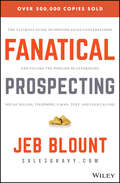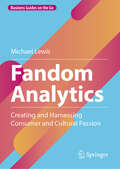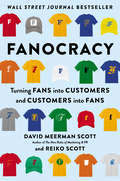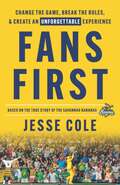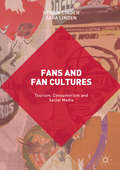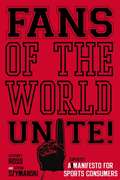- Table View
- List View
Family Wealth Continuity: Building a Foundation for the Future (A Family Business Publication)
by David LanskyMost family business owners and wealth creators share an important vision: perpetuating family and wealth for many generations to come. To ensure wealth continuity, many families put into place various structures, plans, and processes, including estate plans (which may include multiple trusts), ownership succession plans, governance structures/strategies, and others. These sometimes-elaborate plans are aimed at preserving family wealth. In reality, for many families, they don’t. In fact, it has been estimated that a majority of estate plans in place fail, largely as a result of family conflict or communication problems. Author David Lansky reveals here that too many one-size-fits-all and elaborate continuity plans fail to take into account the idiosyncratic family factors that can interfere with continuity planning. Lansky details further how building the right foundation will help families implement the best continuity plans. Addressing that foundation effectively includes understanding the building blocks that make it up, assessing their strengths, and developing strategies to improve them. The specific building blocks include:• Learning Capacity • Familyness • Safe Communication Culture • Commitment to Personal Development• Effective Leadership of ChangeWhile richly informative, this book is not intended as a training manual, but rather as a starting point for important ideas and conversations. In fact, the goal of this book is to help families consider several related factors that go into a foundation for continuity, and to build more effective continuity plans and strategies based on their assessments.
Family Wealth Management
by Mark Haynes Daniell Tom McculloughIntroducing a fresh perspective on wealth management, with proven solutions to the challenges of preserving wealth and investing well in turbulent times Family Wealth Management is coauthored by two experts in the field of private wealth - one, a former director of Bain & Company and the chairman of two of the world's largest family trusts, and the other, a CEO of a leading global family office and professor of finance from University of Toronto. The book introduces you to a unique model of wealth management that produces the desired return outcomes while being consistent with a family's overarching goals and values. The approach combines the best traditional investment and portfolio management practices with innovative new approaches designed to successfully navigate through economic climates both fair and foul. While the authors address the critical "hard" issues of asset management, they also emphasize important "soft" issues of working with families to ensure that actions are congruent with objectives, in alignment with family governance principles and designed to help sustain and grow family wealth over multiple generations. The authors provide clear guidance on how to master each component. How to establish clear family vision, values, and goals as a critical foundation to a sound wealth management strategy How to establish a practical, integrated investment framework that will ensure a consistent, disciplined approach in all environments How to set a long-term family wealth strategy and define an asset allocation model that will produce the desired results How to draft an annual investment policy statement and refine the investment tactics based on capital markets trends and changes in the family's circumstance How to effectively monitor performance and respond to the need for change How to carefully select and manage an ecosystem of experienced, trusted financial advisors who will provide critical guidance through challenging period ahead How to successfully engage and educate the family to preserve and enhance the family's financial wealth and human capital over the generations
Family Wealth: Keeping It in the Family--How Family Members and Their Advisers Preserve Human, Intellectual, and Financial Assets for Generations (Bloomberg #34)
by James E. Hughes Jr.The landmark book that changed the way exceptional families think about their heritage, their wealth, and their legacy to future generations--now revised and expanded. Every family, looking at the next generation, hopes to confer advantages that are more than just material and financial--to inculcate character and leadership, to inspire creativity and enterprise, to help all family members find and follow their individual callings, and to avoid the financial dependency and loss of initiative that can all too often be an unwanted consequence of financial success. Yet many families never succeed in realizing that vision, much less sustaining it for three, four, or five generations and beyond. James Hughes has thought deeply about these challenges, and his insights are at once practical and profound. For more than three decades, he has personally guided multiple generations of families in creating strategies to preserve their human and intellectual capital as well as their financial assets. His teachings synthesize insights from psychology, anthropology, political history, philosophy, economic theory, and the law, with examples ranging from Aristotle to cutting-edge social science theory. His ideas have been taken up by numerous exceptional families, by their advisers, and by scores of authors, practitioners, and academics who have found value in the methods he pioneered. The first edition of this book, privately published, became a word-of-mouth classic. Now, Hughes has updated and substantially expanded it with new chapters that challenge conventional notions of wealth and offer guidelines for conserving family assets in the broadest senses. Filled with tested principles and practices for family governance and joint decision making, it is a rich source of workable wisdom that family members can put into practice today, to the enduring benefit and gratitude of future generations.
Family business models
by Alberto Gimeno Gemma Baulenas Joan Coma-CrosAn exceptional new work on family business, showing how to maintain a balanced relationship between the family and the company, and ensure satisfactory business results. This roadmap helps the reader to build better managed and more stable family firms.
Family, Law, and Inheritance in America
by Yvonne PittsYvonne Pitts explores inheritance practices by focusing on nineteenth-century testamentary capacity trials in Kentucky in which disinherited family members challenged relatives' wills. These disappointed heirs claimed that their departed relative lacked the capacity required to write a valid will. These inheritance disputes crisscrossed a variety of legal and cultural terrains, including ordinary people's understandings of what constituted insanity and justice, medical experts' attempts to infuse law with science, and the independence claims of women. Pitts uncovers the contradictions in the body of law that explicitly protected free will while simultaneously reinforcing the primacy of blood in mediating claims to inherited property. By anchoring the study in local communities and the texts of elite jurists, Pitts demonstrates that "capacity" was a term laden with legal meaning and competing communal values about family, race relations, and rationality. These concepts evolved as Kentucky's legal culture mutated as the state transitioned from a conflicted border state with slaves to a developing free-labor, industrializing economy.
Family, Work and Well-Being: Emergence Of New Issues (SpringerBriefs in Well-Being and Quality of Life Research)
by Mia TammelinThis book analyses the current state-of-the-art research on families, working hours and well-being in Europe, addressing both paid and non-paid work from a family perspective, and introducing emerging issues related to working hours and family life. Further, it discusses the implications of these issues for the well-being of individuals and families. Examining topics such as the division of paid and non-paid work within families, flexibility patterns, the 24/7 society, intensification of work, and the implication of mobile technology for work–family relations, it illustrates how the experiences of working families differ depending on their socio-economic status
Family: The Compact Among Generations (Bloomberg #31)
by James E. Hughes Jr.Why do some families thrive for generations? What accounts for the sad deterioration that others experience? This book takes families and the professionals who serve them beyond the now widely accepted practices offered in Family Wealth and offers a view of Hughes's panoramic insights into what makes families flourish and fail. It lays out the basis for the vision of family governance the author has been developing through his work and research. His advice addresses not only what to do but how to think about the complex issues of family governance, growth, and stability and the ongoing challenge of nurturing the happiness of each family member.
Famine Early Warning Systems: Victims and destitution (Aid and Development Set)
by Peter WalkerIs it possible to see famines coming, to be prepared and to save possibly hundreds of thousands of lives? Or is this the wrong question? A famine is not a single natural catastrophe: it has different stages. Many societies have sophisticated strategies for coping – but these are becoming dramatically limited. Famine Early Warning System is about the people who are caught up in the process of famine. Peter Walker looks at how they perceive their predicament and what they do to avert mass starvation: and at what genuinely useful help can be offered in order to prevent irreversible disaster. Originally published in 1989
Famine and Finance
by Tyler Beck GoodspeedThis book utilizes archival data to examine how access to microfinance credit played an important role in facilitating adjustment to blight during the Great Famine of Ireland. Chapters in the book discuss how Irish farmers adjusted to the major environmental shock, the role of credit institutions and their responses to the potato blight, and the effects of the Great Famine on Irish microfinance institutions themselves. The author argues that the worst affected districts with a microfinance fund experienced substantially smaller population declines and larger increases in buffer livestock during the famine than those districts without a fund. The potentially limited capacity of credit access to mitigate the effects of a major environmental shock on the poorest, most vulnerable borrowers is also a key topic of discussion. Famine and Finance draws on a wealth of archival data to construct an index of blight severity at local level and establish the adjustments made in different districts in response to the Great Famine of Ireland.
Famine and Scarcity in Late Medieval and Early Modern England
by Buchanan SharpSurveying government and crowd responses ranging from the late Middle Ages through to the early modern era, Buchanan Sharp's illuminating study examines how the English government responded to one of the most intractable problems of the period: famine and scarcity. The book provides a comprehensive account of famine relief in the late Middle Ages and evaluates the extent to which traditional market regulations enforced by thirteenth-century kings helped shape future responses to famine and scarcity in the sixteenth century. Analysing some of the oldest surviving archival evidence of public response to famine, Sharp reveals that food riots in England occurred as early as 1347, almost two centuries earlier than was previously thought. Charting the policies, public reactions and royal regulations to grain shortage, Sharp provides a fascinating contribution to our understanding of the social, economic, cultural and political make-up of medieval and early modern England.
Famines in European Economic History: The Last Great European Famines Reconsidered (Routledge Explorations in Economic History)
by Declan Curran Lubomyr Luciuk Andrew G. NewbyThis volume explores economic, social, and political dimensions of three catastrophic famines which struck mid-nineteenth and early-twentieth century Europe; the Irish Famine (An Gorta Mór ) of 1845–1850, the Finnish Famine (Suuret Nälkävuodet) of the 1860s and the Ukrainian Famine (Holodomor) of 1932/1933. In addition to providing new insights into these events on international, national and regional scales, this volume contributes to an increased comparative historiography in historical famine studies. The parallel studies presented in this book challenge and enhance established understandings of famine tragedies, including: famine causation and culpability; social and regional famine vulnerabilities; core–periphery relationships between nations and regions; degrees of national autonomy and self-sufficiency; as well as famine memory and identity. Famines in European Economic History advocates that the impact and long-term consequences of famine for a nation should be understood in the context of evolving geopolitical relations that extend beyond its borders. Furthermore, regional structures within a nation can lead to unevenness in both the severity of the immediate famine crisis and the post-famine recovery. This book will be of interest to those in the fields of economic history, European history and economic geography.
Famous
by Stan CharnofskyWealthy, mega-successful parents reared Harry Schiff to hunger for fame and fortune. At college he sees others throw off family fiats and successfully begin to define themselves. He meets Juliet, driven to be an actor, sensuous, passionate, yet never with commitment. His good friend, Katy Bloom, also a striving actor, becomes his confidante, secretly in love with him. A fourth buddy, Galen Thurston, an Adonis, blessed with Hollywood connections, gets a seeming break because of his father, but with strings. A tragedy explodes when Galen discovers his father’s ugly secret. The group’s chemistry is altered with an intrigue that involves both Harry’s and Galen’s parents. Juliet is on her rocket to fame, her own family’s tale so sordid that she cannot tolerate her father’s presence. Is Harry Juliet’s toy? She would deny it, but eventually, Harry must face off his two demons: his parents’ domination and Juliet’s emotional indifference. Resolution comes when he gets a heady break, screws up his courage to confront his issues, and sees Katy Bloom in another light. To be true to himself becomes more important than to become famous.
Famous Brand Names & Their Origins
by Kathy Martin&“This fascinating and enjoyable book tells the story of around 200 brand names, delving succinctly into their origins and fortunes over time&” (Your Family History). Many brands, including Boots, Hoover, and Kelloggs, were named after their founders whilst others have less obvious origins; for instance, did you know that Velcro comes from velours and crochet, the French words for &“velvet&” and &“hook?&” This entertaining book by Kathy Martin explores the stories behind the brands, their names, and their founders. Bursting with fascinating facts and period advertising, this must-read book will appeal to everyone interested in advertising, social history, food, and famous names. &“A well-written, slightly idiosyncratic and thoroughly delightful book. That the author knows and loves her subject is very evident . . . It is likely to have wide appeal, and be of use to both Historians and Joe and Jane Public.&” —NZ Crown Mines
Famous-Barr: St. Louis Shopping at Its Finest (Landmarks)
by Edna Campos GravenhorstFor ninety-five years, St. Louis residents counted on Famous-Barr to buy the things they used every day and to celebrate the moments that happened only once a year. Customers might bump into Sophia Loren while shoe shopping or confide in Santa Claus during a visit to Toyland. May Company purchased the Famous Clothing Company in 1892 and acquired the William Barr Dry Goods Company nineteen years later. In 1914, Famous-Barr opened the doors of its iconic downtown location, treating folks across Missouri and Illinois to almost a century of spectacular window displays and legendary luncheons.
Fan Pier
by William J. Poorvu Katherine SweetmanThe owner of the Fan Pier site in South Boston has been found legally responsible for blocking the efforts of his development partner in attaining the approval necessary to build the $800 million megaproject they had planned together. It was believed that the owner hoped to structure a new relationship with some other partner who would share more of the economic benefits. The feuding partners need to decide how to handle the recent ruling. This case provides an opportunity to expose students to megaprojects: issues of partnership, design, architecture, changing marketing, and local politics play large roles.
Fanatical Military Recruiting: The Ultimate Guide to Leveraging High-Impact Prospecting to Engage Qualified Applicants, Win the War for Talent, and Make Mission Fast
by Jeb BlountMilitary Recruiting is a war. It’s just a different kind of war than what you were prepared and trained to fight for. Recruiting is a war for talent. Smart, competent, and capable people are rare and in high demand. Every organization, from commercial enterprises, healthcare, non-profit, sports, and education, to the military is in an outright battle to recruit and retain these bright and talented people. Rather than bullets and bombs, the war for talent is won through high-impact prospecting activity, time discipline, intellectual agility, emotional intelligence, and human to human relationships. On this highly competitive, ever changing, asymmetrical battlefield, to win, you must operate at a level of excellence beyond anything asked of military recruiters before. Yet, in this new paradigm, many recruiters are struggling, and most recruiting units are staring down the barrel at 50 percent or more of their recruiters consistently missing Mission. It is imperative that we arm military recruiters with the skills they need to win in this challenging environment. The failure to make Mission is an existential threat to the strength and readiness of America’s fighting forces and our democracy. Fanatical Military Recruiting begins where the Recruiting and Retention colleges of the various branches of the military leave off. It is an advanced, master’s level training resource designed specifically for the unique demands of Military Recruiting. In FMR, you’ll learn: The Single Most Important Discipline in Military Recruiting How to Get Out of a Recruiting Slump The 30-Day Rule and Law of Replacement Powerful Time and Territory Management Strategies that Put You in Control of Your Day The 7 Step Telephone Prospecting Framework The 4 Step Email and Direct Messaging Framework The 5 C’s of Social Recruiting The 7 Step Text Message Prospecting Framework How to Leverage a Balanced Prospecting Methodology to Keep the Funnel Full of Qualified Applicants Powerful Human Influence Frameworks that Reduce Resistance and Objections The 3 Step Prospecting Objection Turn-Around Framework Mission Drive and the 5 Disciplines of Ultra-High Performing Military Recruiters In his signature right-to-the-point style that has made him the go-to trainer to a who’s who of the world’s most prestigious organizations, Jeb Blount pulls no punches. He slaps you in the face with the cold, hard truth about what’s really holding you back. Then, he pulls you in with stories, examples, and lessons that teach you exactly what you need to do right now to become an ultra-high performing recruiter. Fanatical Military Recruiting is filled with the high-powered strategies, techniques, and tools you need to keep your funnel packed with qualified applicants. As you dive into these powerful insights, and with each new chapter, you’ll gain greater and greater confidence. And, with this new-found confidence, your performance as a military recruiter will soar and you will Make Mission, Fast.
Fanatical Prospecting: The Ultimate Guide to Opening Sales Conversations and Filling the Pipeline by Leveraging Social Selling, Telephone, Email, Text, and Cold Calling
by Jeb BlountDitch the failed sales tactics, fill your pipeline, and crush your numberFanatical Prospecting gives salespeople, sales leaders, entrepreneurs, and executives a practical, eye-opening guide that clearly explains the why and how behind the most important activity in sales and business development—prospecting.The brutal fact is the number one reason for failure in sales is an empty pipe and the root cause of an empty pipeline is the failure to consistently prospect. By ignoring the muscle of prospecting, many otherwise competent salespeople and sales organizations consistently underperform. Step by step, Jeb Blount outlines his innovative approach to prospecting that works for real people, in the real world, with real prospects. Learn how to keep the pipeline full of qualified opportunities and avoid debilitating sales slumps by leveraging a balanced prospecting methodology across multiple prospecting channels. This book reveals the secrets, techniques, and tips of top earners. You’ll learn: Why the 30-Day Rule is critical for keeping the pipeline full Why understanding the Law of Replacement is the key to avoiding sales slumps How to leverage the Law of Familiarity to reduce prospecting friction and avoid rejection The 5 C’s of Social Selling and how to use them to get prospects to call you How to use the simple 5 Step Telephone Framework to get more appointments fast How to double call backs with a powerful voice mail technique How to leverage the powerful 4 Step Email Prospecting Framework to create emails that compel prospects to respond How to get text working for you with the 7 Step Text Message Prospecting Framework And there is so much more! Fanatical Prospecting is filled with the high-powered strategies, techniques, and tools you need to fill your pipeline with high quality opportunities. In the most comprehensive book ever written about sales prospecting, Jeb Blount reveals the real secret to improving sales productivity and growing your income fast. You’ll gain the power to blow through resistance and objections, gain more appointments, start more sales conversations, and close more sales. Break free from the fear and frustration that is holding you and your team back from effective and consistent prospecting. It's time to get off the feast or famine sales roller-coaster for good!
Fandom Analytics: Creating and Harnessing Consumer and Cultural Passion (Business Guides on the Go)
by Michael LewisThe success of modern sports, entertainment, political, and other cultural categories is driven by organizations’ ability to create and manage fandom. This book explores fandom from a marketing perspective providing a multidisciplinary framework for understanding, measuring, and growing fandom. It provides a fandom analytics framework for creating and managing fandom and identifies the macro forces (technology, demographics, etc.) that are changing fandom’s structure and societal role. The book goes beyond understanding the foundations of fandom by demonstrating how marketing tools may be employed to value and manage fandom assets. It is designed for existing and new generations of sports and entertainment professionals, as well as scholars, students, and academics interested in sports and entertainment marketing and analytics.
Fandom for Us, by Us: The Pleasures and Practices of Black Audiences (Postmillennial Pop)
by Alfred L. Jr.The convergence of the politics of representation and Black fan culturesBoldly going where few fandom scholars have gone before, Fandom for Us, by Us breaks from our focus on white fandom to center Black fandoms. Alfred L. Martin, Jr., engages these fandoms through what he calls the “four C’s”: class, clout, canon, and comfort.Class is a key component of how Black fandom is contingent on distinctions between white, nationally recognized cultural productions and multicultural and/or regional cultural productions, as demonstrated by Misty Copeland’s ascension in American Ballet Theatre. Clout refers to Black fans’ realization of their own consumer spending power as an agent for industrial change, reducing the precarity of Blackness within historically white cultural apparatuses and facilitating the production of Black blockbusters like 2018’s Black Panther. Canon entails a communal fannish practice of sharing media objects, like the 1978 film The Wiz, which lead them to take on meanings outside of their original context. Comfort describes the nostalgic and sentimental affects associated with beloved fan objects such as the television show, Golden Girls, connected to notions of Black joy and signaling moments wherein Black people can just be themselves.Through 75 in-depth interviews with Black fans, Fandom for Us, by Us argues not only for the importance of studying Black fandoms, but also demonstrates their complexities by both coupling and decoupling Black reception practices from the politics of representation. Martin highlights the nuanced ways Black fans interact with media representations, suggesting class, clout, canon, and comfort are universal to the study of all fandoms. Yet, for all the ways these fandoms are similar and reciprocal, Black fandoms are also their own set of practices, demanding their own study.
Fannie Mae: Public or Private?
by David A. Moss Cole BoltonIn 1987, President Ronald Reagan established the President's Commission on Privatization to identify federal government functions that could be shifted to the private sector. One agency that the Commission considered was the Federal National Mortgage Association, or Fannie Mae. Fannie Mae was a Depression-era creation that was charged with establishing a secondary market for home loans. By purchasing qualifying residential mortgages from individual home loan issuers, Fannie Mae provided these institutions with funds for the continued issuance of mortgages, thereby promoting the government's goal of increased homeownership. Although lawmakers had already partially privatized Fannie Mae in 1954 and again in 1968, the agency in 1987 still retained close links to the federal government, including an emergency line of credit from the U.S. Treasury. After its deliberations, the President's Commission recommended Fannie Mae be restructured into a fully private firm. Now it was up to Congress and the President to decide whether to accept and implement the Commission's findings.
Fanocracy: Turning Fans into Customers and Customers into Fans
by David Meerman Scott Reiko ScottFrom the bestselling author of New Rules of Marketing & PR, a bold guide to converting customer passion into marketing power. How do some brands attract word-of-mouth buzz and radical devotion around products as everyday as car insurance, surfboards, and underwear? They embody the most powerful marketing force in the world: die-hard fans. In this essential book, leading business growth strategist David Meerman Scott and fandom expert Reiko Scott interview young entrepreneurs, veteran business owners, startup founders, nonprofits, and companies big and small to pinpoint which practices separate organizations that flourish from those stuck in stagnation. They lay out a road map for converting customers&’ ardor into buying power, pulling one-of-a-kind examples from a wide range of organizations, including: · MeUndies, the subscription company that&’s revolutionizing underwear · HeadCount, the nonprofit that registers voters at music concerts · Grain Surfboards, the board-building studio that willingly reveals its trade secrets with customers · Hagerty, the classic-car insurance provider with over 600,000 premier club members · HubSpot, the software company that draws 25,000 attendees to its annual conference For anyone who seeks to harness the force of fandom to revolutionize his or her business, Fanocracy shows the way.
Fans First: Change the Game, Break the Rules and Create an Unforgettable Experience
by Jesse ColeThe Savannah Bananas should not exist. <p> You can't name any of their players. They play in a 1920s-era ballpark with no ads or billboards. They play in kilts, stilts, and stilettos. They even have an all-grandma dance team: the Banana Nanas. <p><p> Everything the Bananas do is unconventional. It shouldn’t work. <p><p> And yet they sell out every game, have a waitlist in the thousands, ship merchandise around the globe, and entertain millions of followers on social media. <p><p> ESPN calls the Bananas “the greatest show in baseball.” <p><p> How is this even possible? <p><P> Two words: Fans First. <p><p> Packed with behind-the-peel stories, hard-earned lessons, and a few other surprises, Fans First teaches you how to stand out in your marketplace, drive explosive growth, and inspire fanatical loyalty. <p><p> If this all sounds bananas, that’s the point. Normal leaders read normal books and get normal results. But if you’re ready to change the game, break the rules, and create your own unforgettable team, then it’s time to go Fans First.
Fans and Fan Cultures
by Henrik Linden Sara LindenExploring the ambiguous relationship between fandom and consumer culture, this book provides a critical overview of fans, fan cultures and fan experiences in relation to the broader experience and transformation economy. Fans and Fan Cultures discusses key theoretical concepts concerning celebrity, fandoms, subculture, consumerism and marketing through a range of examples in film, travel and tourism, football and music. With an emphasis on social media, and how various online platforms are utilised by brands, artists and fans, the authors explore how this type of communication often contributes to trivialising authentic expressions of cultural and social values and identities.
Fans of the World, Unite!
by Stefan Szymanski Stephen F. RossRoss (law, Pennsylvania State U. ) and Szymanski (economics, City U. London, UK) have written this "manifesto" for sports fans who are perplexed and frustrated by the owners of sports teams who appear to make decisions out of greed instead of the spirit of competition. The authors propose a complete restructuring of sports leagues through the strict enforcement of rules, the reduction of conflicts of interest among owners and policies of promotion and relegation. This book also weighs the pros and cons of such organizational strategies as "closed" leagues, entry by merit, the "Contest Theory" and competitive balance. Annotation ©2009 Book News, Inc. , Portland, OR (booknews. com)
